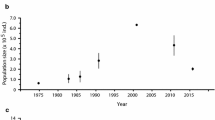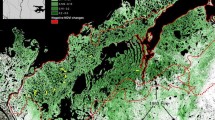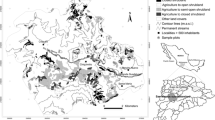Abstract
Recent climate changes have increased the primary productivity of many Arctic and subarctic regions. Erected shrub has been shown to increase in abundance over the last decades in northern regions in response to warmer climate. At the same time, caribou herds are declining throughout the circumboreal regions. Based on observation of heavy browsing on shrubs at Deception Bay (Nunavik, Canada), we hypothesized that the densification of shrubs observed in nearby locations did not occur at our study site despite of observed warming because of a recent peak of the Rivière-aux-Feuilles caribou herd. To assess shrub cover changes, we compared a 1972 mosaic of aerial photos to a 2010 satellite image over a 5 km2 area, divided into 56 grids of 100 30 m × 30 m cells. Most cells (n = 4,502) did not show any changes in the cover of shrubs but those who did were as likely to increase as to decrease. The relative cover of shrubs in cells who changed was not higher in 2010 (6.1 ± 0.2 %) than in 1972 (7.3 ± 0.4 %). More than 70 % of birch and willow had more than 50 % of their shoot browsed, suggesting that caribou may limit shrub expansion at this site. We cannot rule out that abiotic factors also contribute to the inertia in shrub cover. Increases in shrub abundance reported in Nunavik and elsewhere were located closer to the tree line or in discontinuous permafrost, whereas our site is characterized by herbaceous arctic tundra, continuous permafrost and relatively low annual precipitation.






Similar content being viewed by others
References
Agresti A (1996) An introduction to categorical data analysis. Wiley, New York
Allard M, Lemay M (2013) Le Nunaviq et le Nunavisiavut: de la science aux politiques publiques. Une étude intégrée d’impact régional des changements climatiques et de la modernisation. ArcticNet Inc., Québec
Allard M, Seguin MK (1987) Le pergélisol au Québec nordique: bilan et perspective. Geogr Phys Quat 41:141–152
Aune S, Hofgaard A, Soderstrom L (2011) Contrasting climate- and land-use-driven tree encroachment patterns of subarctic tundra in northern Norway and the Kola Peninsula. Can J For Res 41:437–449
Bhatt US, Walker DA, Raynolds MK, Comiso JC, Epstein HE, Jia G, Gens R, Pinzon JE, Tucker CJ, Tweedie CE, Webber PJ (2010) Circumpolar arctic tundra vegetation change is linked to sea ice decline. Earth Interactions 14:1–20
Boudreau S, Payette S (2004) Caribou-induced changes in species dominance of lichen woodlands: an analysis of plant remains. Am J Bot 91:422–429
Bråthen KA, Oksanen J (2001) Reindeer reduce biomass of preferred plant species. J Veg Sci 12:473–480
Bret-Harte MS, Shaver GR, Zoerner JP, Johnstone JF, Wagner JL, Chavez AS, Gunkelman RF, Lippert SC, Laundre JA (2001) Developmental plasticity allows Betula nana to dominate tundra subjected to an altered environment. Ecology 82:18–32
Cahoon SMP, Sullivan PF, Post E, Welker JM (2011) Large herbivores limit CO2 uptake and suppress carbon cycle responses to warming in West Greenland. Glob Change Biol 18:469–479
CEN (2013) Données environnementales de la région de Salluit au Nunavik, Québec, Canada, v 1.1 (1987-2012). Nordicana D3
Champagne E, Tremblay JP, Côté SD (2012) Tolerance of an expanding subarctic shrub, Betula glandulosa, to simulated caribou browsing. PLoS ONE 7:e51940
Chapin FS, Shaver GR, Giblin AE, Nadelhoffer KJ, Laundre JA (1995) Responses of arctic tundra to experimental and observed changes in climate. Ecology 76:694–711
Couturier S, Jean D, Otto R, Rivard S (2004) Démographie des troupeaux de caribous migrateurs-toundriques (Rangifer tarandus) au Nord-du-Québec et au Labrador. Ministère des Ressources naturelles, de la Faune et des Parcs, Direction de l’aménagement de la faune du Nord-du-Québec, Direction de la recherche sur la faune, Québec
Crête M, Doucet GJ (1998) Persistent suppression in dwarf birch after release from heavy summer browsing by caribou. Arct Alp Res 30:126–132
Dray S, Dufour AB (2007) The ade4 package: implementing the duality diagram for ecologists. J Stat Softw 22:1–20
Duan N (1983) Smearing estimate: a nonparametric retransformation method. J Am Statist Assoc 78:605–610
Elmendorf SC et al (2012a) Global assessment of experimental climate warming on tundra vegetation: heterogeneity over space and time. Ecol Lett 15(2):164–175
Elmendorf SC et al (2012b) Plot-scale evidence of tundra vegetation change and links to recent summer warming. Nature Clim Change 2(6):453–457
Festa-Bianchet M, Ray JC, Boutin S, Côté SD, Gunn A (2011) Conservation of caribou (Rangifer tarandus) in Canada: an uncertain future. Can J Zool 89:419–434
Glencore Mine Raglan (2013). Raglan mine geography. http://www.xstratanickelraglan.ca/EN/Operations/Pages/Geography.aspx. Accessed 22 July 2013
Hallinger M, Manthey M, Wilmking M (2010) Establishing a missing link: warm summers and winter snow cover promote shrub expansion into alpine tundra in Scandinavia. New Phytol 186:890–899
Hofgaard A, Løkken JO, Dalen L, Hytteborn H (2010) Comparing warming and grazing effects on birch growth in an alpine environment: a 10-year experiment. Plant Ecol Divers 3:19–27
Hudson JMG, Henry GHR (2009) Increased plant biomass in a High Arctic heath community from 1981 to 2008. Ecology 90(10):2657–2663
IPCC (2007) Climate Change 2007: synthesis report. Intergovernmental Panel on Climate Change, Geneva
Jefferies RL, Klein DR, Shaver GR (1994) Vertebrate herbivores and northern plant communities: reciprocal influences and responses. Oikos 71:193–206
Le Hénaff D (1976) Inventaire aérien des terrains de vêlage du caribou dans la région du nord et au nord du territoire de la municipalité de la Baie-James (mai-juin 1975). Ministère du Tourisme, de la Chasse et de la Pêche, Québec
Lévesque AM (2009) Salluit: analyse et reconstitution d’évènements climatiques significatifs pertinents à l’aménagement du territoire et à la sécurité publique. Thesis, Université Laval
Mack MC, Schuur EAG, Bret-Harte MS, Shaver GR, Chapin FS (2004) Ecosystem carbon storage in arctic tundra reduced by long-term nutrient fertilization. Nature 431(7007):440–443
Manseau M (1996) Relation réciproque entre les caribous et la végétation des aires d’estivages: le cas du troupeau de caribous de la rivière George. Thesis, Université Laval
Manseau M, Huot J, Crete M (1996) Effects of summer grazing by caribou on composition and productivity of vegetation: community and landscape level. J Ecol 84:503–513
Maycock PF, Matthews B (1966) An arctic forest in tundra of northern Ungava, Quebec. Arctic 19:114–144
McManus KM, Morton DC, Masek JG, Wang D, Sexton JO, Nagol JR, Ropars P, Boudreau S (2012) Satellite-based evidence for shrub and graminoid tundra expansion in northern Quebec from 1986 to 2010. Glob Change Biol 18:2313–2323
Mesinger F, DiMego G, Kalnay E, Mitchell K, Shafran PC, Ebisuzaki W, Jović D, Woollen J, Rogers E, Berbery EH, Ek MB, Fan Y, Grumbine R, Higgins W, Li H, Lin Y, Manikin G, Parrish D, Shi W (2006) North American regional reanalysis. Bull Amer Meteor Soc 87:343–360
MRN (2001) Le système hiérarchique de classification écologique du territoire. Ministère des Ressources naturelles du Québec, Direction des inventaires forestiers, Québec
MRN (2002) Carte géologique du Québec. Édition 2002. DV 2002-06 edn. Ministère des Ressources Naturelles, Québec
Myers-Smith IH, Forbes BC, Wilmking M, Hallinger M, Lantz T, Blok D, Tape KD, Macias-Fauria M, Sass-Klaassen U, Levesque E, Boudreau S, Ropars P, Hermanutz L, Trant A, Collier LS, Weijers S, Rozema J, Rayback SA, Schmidt NM, Schaepman-Strub G, Wipf S, Rixen C, Menard CB, Venn S, Goetz S, Andreu-Hayles L, Elmendorf S, Ravolainen V, Welker J, Grogan P, Epstein HE, Hik DS (2011a) Shrub expansion in tundra ecosystems: dynamics, impacts and research priorities. Environ Res Lett 6:045509
Myers-Smith IH, Hik DS, Kennedy C, Cooley D, Johnstone JF, Kenney AJ, Krebs CJ (2011b) Expansion of canopy-forming willows over the twentieth century on Herschel Island, Yukon territory, Canada. Ambio 40:610–623
Olofsson J, Oksanen L, Callaghan T, Hulme PE, Oksanen T, Suominen O (2009) Herbivores inhibit climate-driven shrub expansion on the tundra. Glob Change Biol 15(11):2681–2693
Pajunen A, Virtanen R, Roininen H (2012) Browsing-mediated shrub canopy changes drive composition and species richness in forest-tundra ecosystems. Oikos 121(10):1544–1552
Pinheiro JC, Bates DM (2000) Mixed-effects models in S and S-PLUS. Springer, New York
Post E, Pedersen C (2008) Opposing plant community responses to warming with and without herbivores. Proc Natl Acad Sci USA 105(34):12353–12358
R Development Core Team (2011) R: a language and environment for statistical computing. R Foundation for Statistical Computing, Vienna
Ropars P, Boudreau S (2012) Shrub expansion at the forest-tundra ecotone: spatial heterogeneity linked to local topography. Environ Res Lett 7:015501
Rustad LE, Campbell JL, Marion GM, Norby RJ, Mitchell MJ, Hartley AE, Cornelissen JHC, Gurevitch J, Gcte N (2001) A meta-analysis of the response of soil respiration, net nitrogen mineralization, and aboveground plant growth to experimental ecosystem warming. Oecologia 126:543–562
Sekhon J (2011) Multivariate and propensity score matching software with automated balance optimization: the Matching package for R. J Stat Softw 42:1–52
Speed JDM, Austrheim G, Hester AJ, Solberg EJ, Tremblay JP (2013) Regional-scale impacts alteration of moose browsing on the regeneration of clear-cut forests by moose browsing. Forest Ecol Manag 289:289–299
Sturm M, Racine C, Tape K (2001) Increasing shrub abundance in the Arctic. Nature 411(6837):546–547
Sturm M, Schimel J, Michaelson G, Welker JM, Oberbauer SF, Liston GE, Fahnestock J, Romanovsky VE (2005) Winter biological processes could help convert arctic tundra to shrubland. Bioscience 55:17–26
Tape K, Sturm M, Racine C (2006) The evidence for shrub expansion in Northern Alaska and the Pan-Arctic. Glob Change Biol 12:686–702
Tape KD, Hallinger M, Welker JM, Ruess RW (2012) Landscape heterogeneity of shrub expansion in arctic Alaska. Ecosystems 15:711–724
Tremblay B, Lévesque E, Boudreau S (2012) Recent expansion of erect shrubs in the Low Arctic: evidence from Eastern Nunavik. Environ Res Lett 7:035501
Vors LS, Boyce MS (2009) Global declines of caribou and reindeer. Glob Change Biol 15(11):2626–2633
Walker MD, Wahren CH, Hollister RD, Henry GHR, Ahlquist LE, Alatalo JM, Bret-Harte MS, Calef MP, Callaghan TV, Carroll AB, Epstein HE, Jonsdottir IS, Klein JA, Magnusson B, Molau U, Oberbauer SF, Rewa SP, Robinson CH, Shaver GR, Suding KN, Thompson CC, Tolvanen A, Totland O, Turner PL, Tweedie CE, Webber PJ, Wookey PA (2006) Plant community responses to experimental warming across the tundra biome. Proc Natl Acad Sci USA 103:1342–1346
Walther GR, Post E, Convey P, Menzel A, Parmesan C, Beebee TJC, Fromentin J-M, Hoegh-Guldberg O, Bairlein F (2002) Ecological responses to recent climate change. Nature 416:389–395
Yu Q, Epstein HE, Walker DA, Frost GV, Forbes BC (2011) Modeling dynamics of tundra plant communities on the Yamal Peninsula, Russia, in response to climate change and grazing pressure. Environ Res Lett 6:1–12
Acknowledgments
This project is part of the Caribou Ungava research program (http://www.caribou-ungava.ulaval.ca/en/accueil/) funded by Natural Science and Engineering Research Council of Canada, Ressources Naturelles et Faune Québec, Network of centers of excellence ArcticNet, Fonds de recherche sur la nature et les technologies du Gouvernement du Québec, Hydro Québec, Xstrata Nickel, Fédération des pourvoiries du Québec inc., Fédération Québécoise des chasseurs et pêcheurs, First Air, Makivik Corporation, CircumArctic Rangifer Monitoring and Assessment, International Polar Year, Canada Foundation for Innovation, Institute for Environmental Monitoring and Research, Fondation de la Faune du Québec, Ouranos, the Canadian Wildlife Federation, and the Northern Scientific Training Program. We are particularly indebted to Xstrata Nickel-Raglan Mine for their collaboration, logistical support and the continuous use of their infrastructures. The Quarqalik landholding corporation of Salluit welcomed our team on their land. Thanks to Raglan Mine employees, B. Doyon, V. Saucier, J. Boulanger-Pelletier for fieldwork, and to E. L’Hérault of Centre d’Études Nordiques and M. LeCorre for help with the analyses. G Daigle from the Service de consultation statistique at Université Laval provided statistical guidance.
Author information
Authors and Affiliations
Corresponding author
Rights and permissions
About this article
Cite this article
Plante, S., Champagne, E., Ropars, P. et al. Shrub cover in northern Nunavik: can herbivores limit shrub expansion?. Polar Biol 37, 611–619 (2014). https://doi.org/10.1007/s00300-014-1461-6
Received:
Revised:
Accepted:
Published:
Issue Date:
DOI: https://doi.org/10.1007/s00300-014-1461-6




